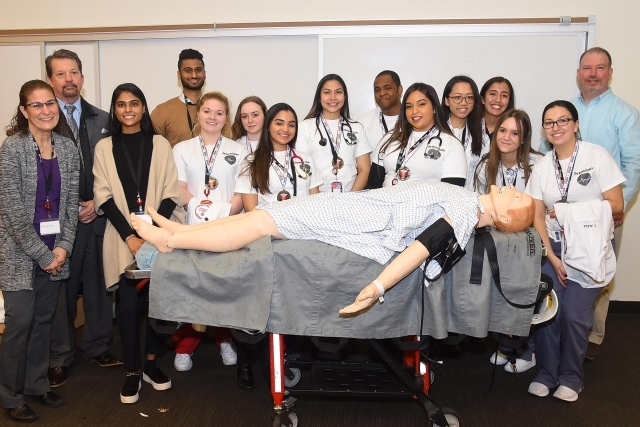

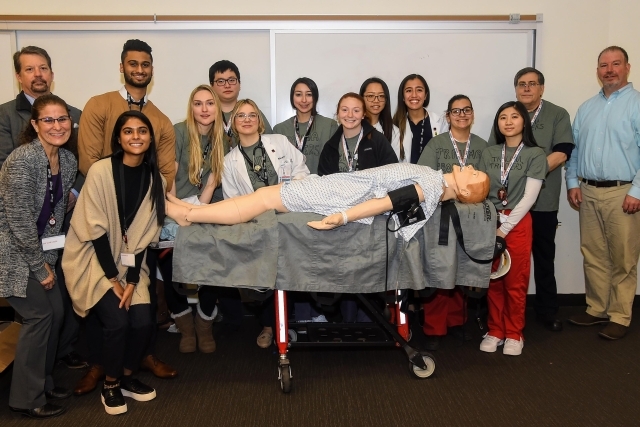
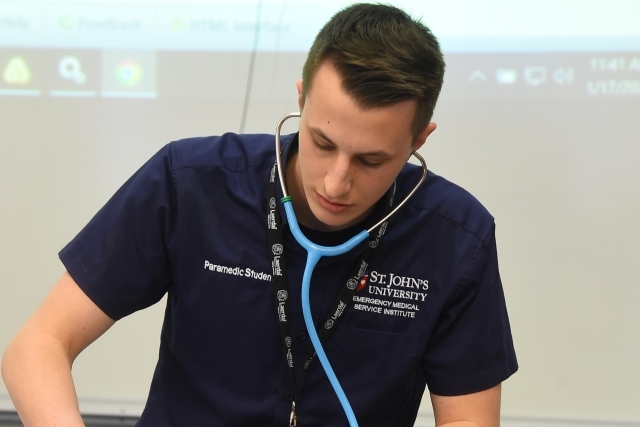
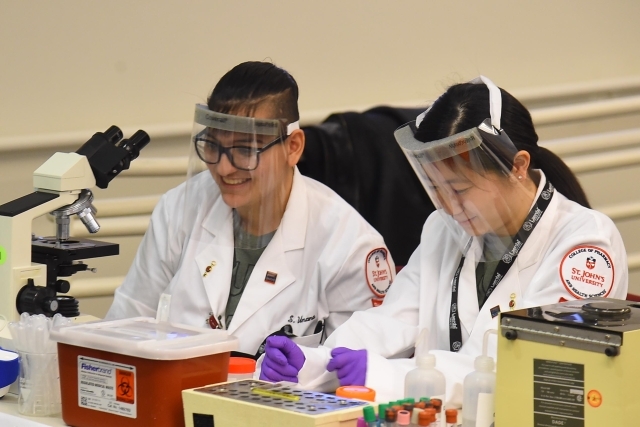
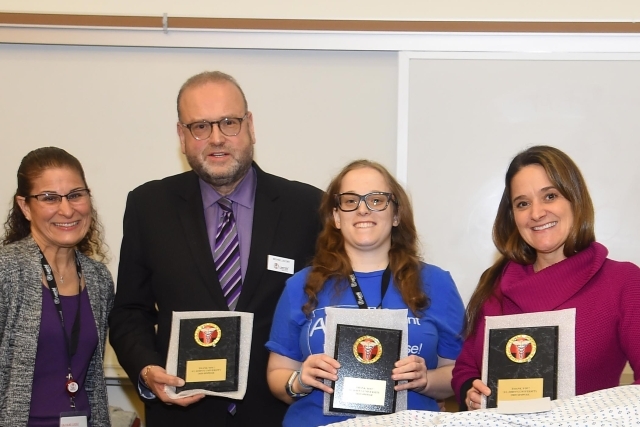
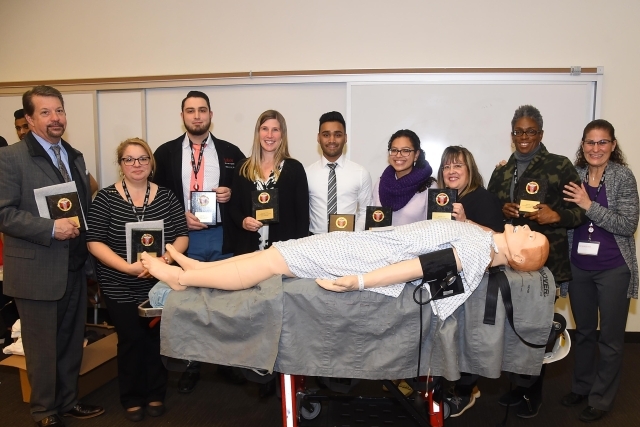
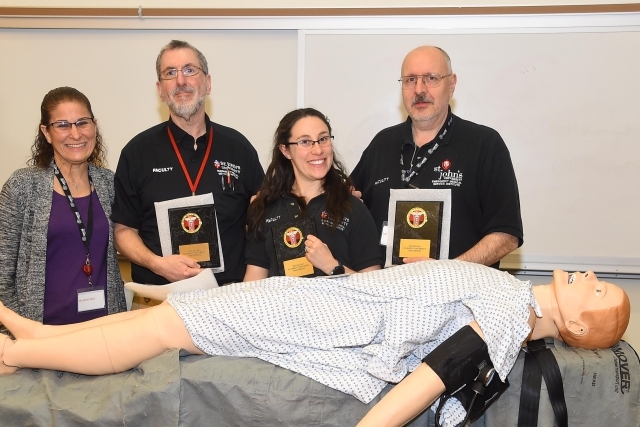
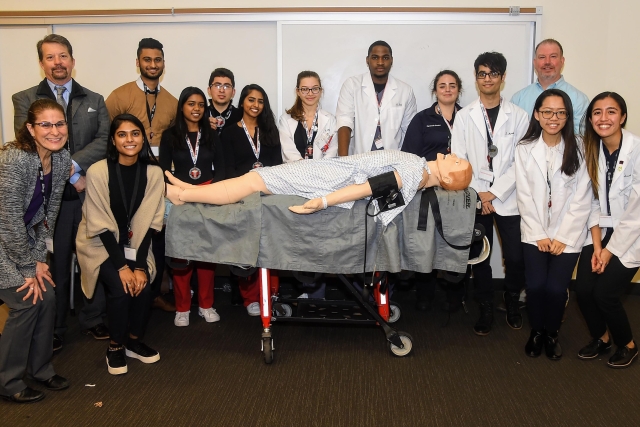
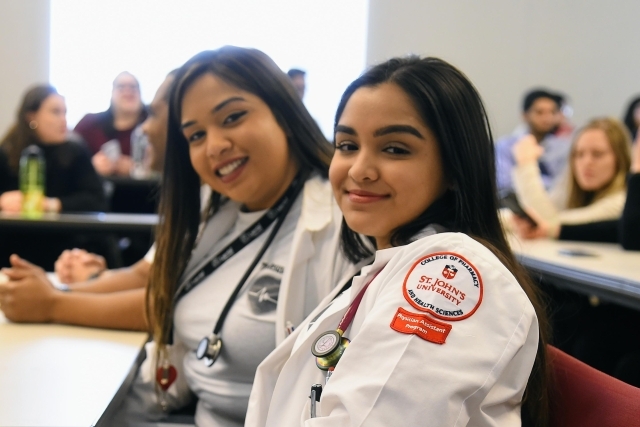










It was a scene typical of a spiraling medical emergency: health-care workers scramble to stabilize a patient with life-threatening symptoms related to pneumonia.
But in this instance, the health-care providers were students at St. John’s University’s College of Pharmacy and Health Sciences (CPHS). The patient was a full-body simulator mannequin, programmed to respond like a person with an illness.
The simulated drama unfolded on Friday, January 17, inside the D’Angelo Center on the Queens, NY, campus before an audience of health professionals and students who were invited to observe the CPHS’s first-ever Interprofessional Simulation Medical Competition.
“The purpose of full-body simulators is to allow students to practice lifesaving skills in a safe environment with no risk of patient harm,” said Stacey Singer-Leshinsky, M.S. Ed., RPAC, project director for the competition and Associate Professor, Physician Assistant program, CPHS.
The 30 participating students were organized into three teams of 10 students each, and they represented five health professions they are studying at St. John’s—clinical laboratory sciences, paramedic, pharmacy, physician assistant, and radiologic sciences. The students named their respective teams the Life Savers, the Trauma Troopers, and the Resuscitators, which won the competition.
Each team worked with the same full-body simulator, known as a SimMan Essential. These life-sized patient models can be programmed to display various medical emergencies, such as a heart attack or stroke. They can also breathe and display a pulse, a heartbeat, and other vital signs. In addition, they are designed to respond to simulated medical treatment.
The teams all faced the identical clinical scenario, according to Professor Singer-Leshinsky, and the students collaborated with each other across their respective disciplines of study as they worked to save their patient. Under the scenario, she explained, paramedic students were called to the home of a patient with pneumonia whose condition was worsening and who was developing sepsis, the body’s extreme response to an infection.
“They brought her to the hospital,” said Dr. Singer-Leshinsky, “where they met physician assistant students, who examined and cared for the patient. But the patient became very sick and developed low blood pressure, shock, and an accelerated heart rate.”
The clinical lab science students interpreted blood culture. The pharmacy students helped to select the correct medications to alleviate shock symptoms. The radiology students interpreted x-rays they helped to administer. Paramedics continued with the case in nursing roles.
Carina Acosta, a fifth-year pharmacy student and member of the Resuscitators, was excited by the challenge to respond to the patient in real time. “I watched the monitor with the patient’s vitals and saw her blood pressure drop. I knew we had to act fast,” she said.
Throughout the competition, the students were assessed by an interprofessional team consisting of faculty, graduate students, and professionals from other organizations and universities, including Stony Brook University in Stony Brook, NY; the Division of Training of the Fire Department of New York; and the Practical Nursing Program at the Vocational Education and Extension Board. In addition, there was an interprofessional audience of more than 100 observers who, through audience response, voted for the best team, using criteria such as teamwork skills, communication, clinical decision-making skills, and specific clinical expertise.
“I dreaded the idea of competing in front of so many people,” said physician assistant student Tiffany Daniel, a member of the Resuscitators. “However, once I was out there, it was truly a blast working with each profession to effectively treat the patient. We all had each other’s back and supported each other to the best of our abilities. I believe that is what helped us to win.”
Monica Roman, a paramedic student, came away inspired by making split-second medical decisions in a simulated emergency setting. “Feeling the pressure from all of the judges, classmates, friends, and family who were there to support us, and with all eyes upon us, gave us that same feeling we will face when we actually have a real patient in front of us. This experience is one of the many things that will contribute to our success in the medical field.”
In preparation for the competition, the students attended a “Get to Know You” day earlier in January, during which participants from each of the five professions described to each other their roles and responsibilities in health care. The students engaged in several hands-on activities related to each profession, such as learning about taking x-rays for radiologic sciences, analyzing data with the clinical laboratory science program, practicing procedures with the physician assistant students, touring an ambulance with the paramedic students, and sharing information about pharmaceutical work with pharmacy students.
Monica said the competition underscored the deep commitment CPHS professors routinely devote to thoroughly training their students. “Being able to demonstrate the confidence they have instilled in us was an amazing experience.”
Related News
Dean Jerrold Ross Conference Room Unveiled
On Tuesday, December 10, the newly renovated conference room on the fifth floor of Sullivan Hall was dedicated in honor of Jerrold Ross, Ph.D., former Dean of The School of Education . The renovation...
St. John’s Celebrates Holiday Season at Annual Christmas Tree Lighting and Winter Carnival
Seasonal cheer, festive music, and student enthusiasm filled the Great Lawn with anticipation on December 8 as St. John’s University community members gathered for the return of the campus Christmas Tree lighting and the climax of the 33rd annual Winter Carnival.
Vincent’s Table Brings Dignity and Support to Students Facing Food Insecurity
Food insecurity among US college students is a rising problem. About 3.8 million college students experienced food insecurity in 2020 and it has only grown steadily worse.
